Related Research Articles
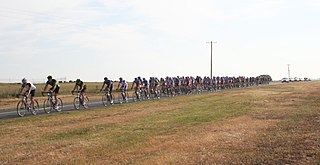
The Melbourne to Warrnambool Classic cycling race is a one-day road bicycle race. The race started in 1895 and is Australia's oldest one day race and the world's second oldest one day race, after the Liège–Bastogne–Liège Classic. Historically until 1938 the race started in Warrnambool and finished 165 miles (266 km) later in Melbourne. In 1895 the race was run in the opposite direction, from Melbourne to Warrnambool and then again from 1939. The route started in the Melbourne central business district and followed the Princes Highway to Warrnambool on Victoria's western coast. This traditional route was the longest race on the Union Cycliste Internationale (UCI) calendar, the exact distance varying slightly over time.

The Australian National Road Race Championships, are held annually with an event for each category of bicycle rider: Men, Women & under 23 riders. The event also includes the Australian National Time Trial Championships since 2002. The Australian Championships were officially known as the Scody Australian Open Road Cycling Championships from 1999 to 2010, taking the name of their main sponsor. This changed to the Mars Cycling Australia Road National Championships from 2011 but they are more commonly referred to as The Nationals. The under 23 championships were introduced in 2001. Note that these results do not currently include the senior and junior amateur road race championships that were held prior to the open era.

Nino Borsari was an Italian cyclist who won a gold medal in the 4000 metres team pursuit event at the 1932 Summer Olympics.

Richard William "Fatty" Lamb was an Australian racing cyclist who competed on both road and track, as was typical of Australian cyclists of the era such as Hubert Opperman. Throughout his career, Lamb was associated with Malvern Star Bicycles and Bruce Small.
Iddo "Snowy" Munro was an Australian racing cyclist. The highlights of his career were winning the Australasian long distance road championship in 1909 and competing in the 1914 Tour de France. Munro won the championship by winning the Blue Riband for the fastest time in the Warrnambool to Melbourne race. Munro set a record time of 7h 12' 51" which was not broken until 1931. Munro had a long association with the Warrnambool and his other efforts were 30th in 1907, 45th and fastest rider receiving over 10 minute start in 1908 and 60th in 1910.
Alby Barlow was an Australian racing cyclist from 1935 who rode for Oakleigh. In 1947 he was the Australian 100 miles road champion and holder of the 25, 50 and 100 miles Australian unpaced road records.
Keith Rowley (1919–1982) was an Australian racing cyclist.
Alby Saunders was an Australian racing cyclist.
Eddie Smith was an Australian racing cyclist. He won the Australian national road race title in 1954 and 1955. Smith finished second in 1956 behind Russell Mockridge.
Frankie Thomas was an Australian racing cyclist who competed on both road and track, as was typical of Australian cyclists of the era such as Hubert Opperman.
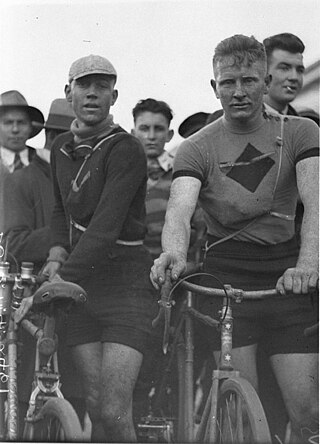
Ernest Milliken was an Australian Road racing cyclist who performed strongly in distance races and individual time trials.

The Goulburn to Sydney cycling race was a one-day road bicycle race. The first race was held in 1902 with the last in 2012.
Walter "Hefty" Stuart (1912–1938) was an Australian cyclist who competed on both road and track, as was typical of Australian cyclists of the era such as Hubert Opperman and Richard Lamb.
Max Rowley was an Australian racing cyclist.
Ernest "Ernie" Bainbridge (1890–1984), also known as Ern Bainbridge, was an Australian racing cyclist, who is best known for competing in the 1928 Tour de France with fellow Australian Percy Osborn and Hubert Opperman and New Zealander Harry Watson.
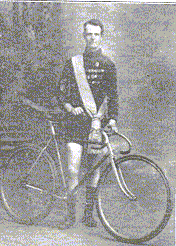
Duncan "Don" Kirkham was an Australian racing cyclist. Kirkham was a regular competitor in Australian long distance cycling races. He won the Goulburn to Sydney Classic in 1910, riding off scratch and setting the fastest time. In 1911 he was 2nd and set the fastest time, riding the 131 miles (211 km) in a record time of 6h 19' 31". Kirkham's time was not beaten until 1925 by Richard "Fatty" Lamb. He had previously finished 5th in 1909. and finished outside the top 20 in 1912.
John Beasley was an Australian racing cyclist and rode in the 1952 and 1955 Tour de France.
Alan "Pete" Angus (1912–1988) was an Australian racing cyclist.
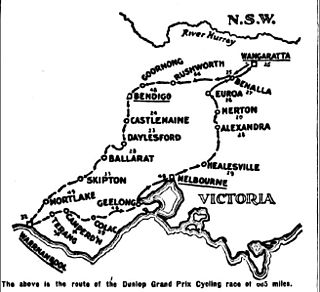
The Dunlop Grand Prix was, in 1927, the biggest cycling race in the British Empire and the richest race in the world. It was organised by the Dunlop Rubber Company which had a long history of organising bicycle races, including the Warrnambool to Melbourne, Colac to Melbourne and Goulburn to Sydney. As a result of the Dunlop Grand Prix, the Warrnambool was not held in 1927 however the Colac and Goulburn races were.
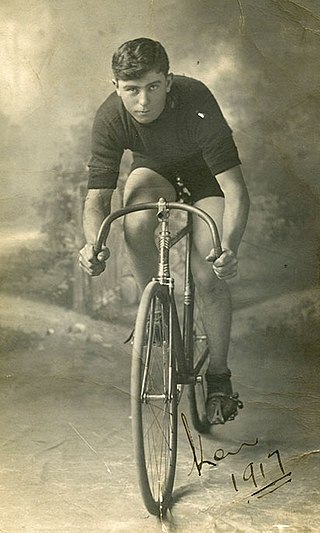
Ken Gordon Ferndale Ross (1900–1974) was an Australian road and track cyclist. His best results were achieved in the Goulburn to Sydney, where he set the fastest time on three occasions and in the Sydney Six-day race which he won three times.
References
- ↑ "Retired but won rich cycling race". The Argus (Melbourne) . Melbourne, Vic.: National Library of Australia. 11 October 1948. p. 14.
- ↑ "Bonney rewarded with win in classic". The Age . Melbourne, Vic.: National Library of Australia. 10 October 1949. p. 12.
- ↑ "Road champ. to Beasley". The Sporting Globe . Melbourne, Vic.: National Library of Australia. 13 October 1951. p. 9.
- ↑ "Peadon cleans up cyclists". The Truth . Sydney, NSW: National Library of Australia. 7 September 1952. p. 22.
- ↑ "NSW rider's easy "W'bool" victory". The Sporting Globe . Melbourne, Vic.: National Library of Australia. 6 October 1951. p. 12.
- ↑ "Long-cherished ambition realised". The Sporting Globe . Melbourne, Vic.: National Library of Australia. 4 October 1952. p. 12.